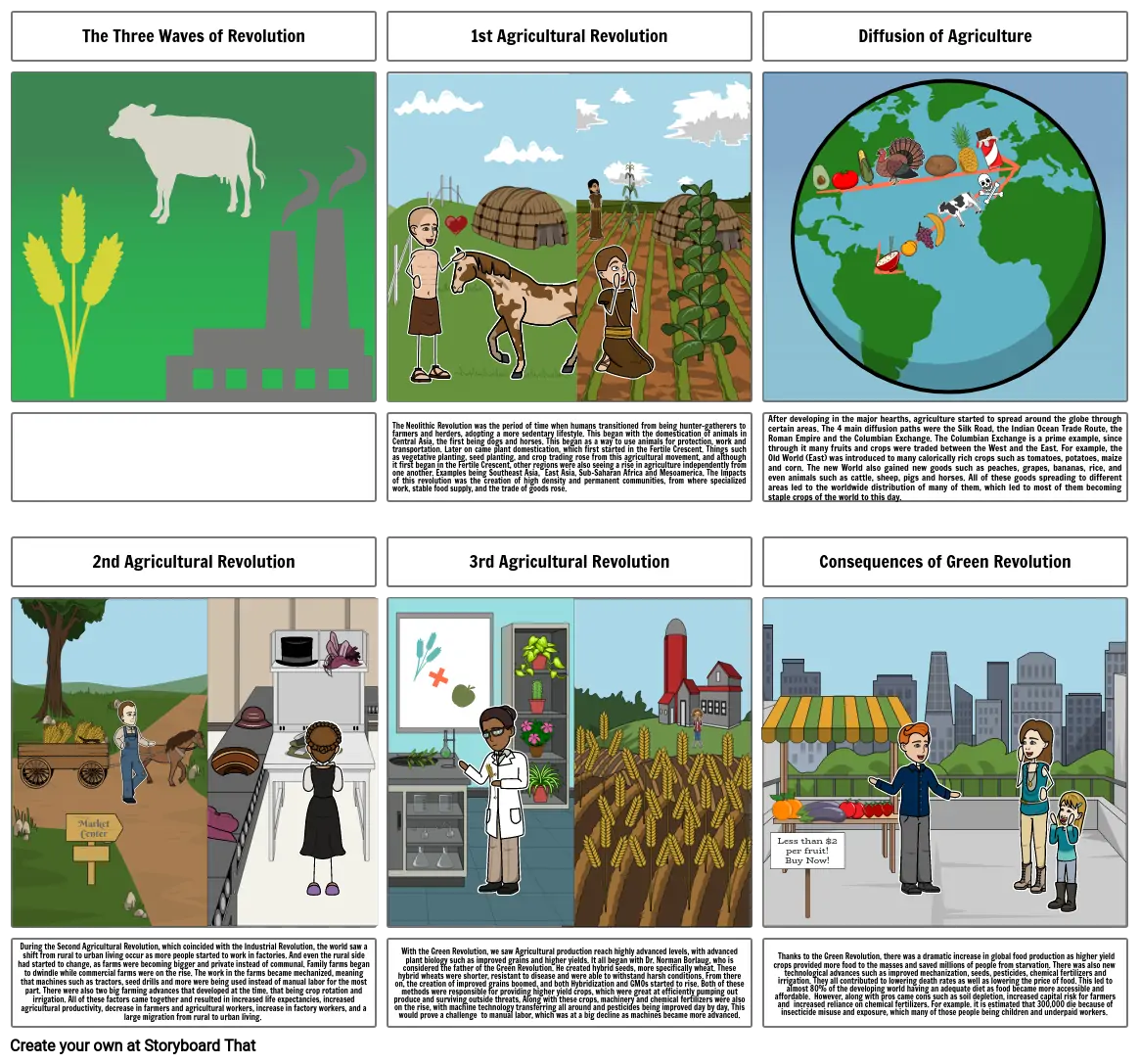The Three Waves of Revolution

Kuvakäsikirjoitus Teksti
- The Three Waves of Revolution
- 1st Agricultural Revolution
- Diffusion of Agriculture
-
- 2nd Agricultural Revolution
- The Neolithic Revolution was the period of time when humans transitioned from being hunter-gatherers to farmers and herders, adopting a more sedentary lifestyle. This began with the domestication of animals in Central Asia, the first being dogs and horses. This began as a way to use animals for protection, work and transportation. Later on came plant domestication, which first started in the Fertile Crescent. Things such as vegetative planting, seed planting, and crop trading rose from this agricultural movement, and although it first began in the Fertile Crescent, other regions were also seeing a rise in agriculture independently from one another. Examples being Southeast Asia, East Asia, Sub-Saharan Africa and Mesoamerica. The Impacts of this revolution was the creation of high density and permanent communities, from where specialized work, stable food supply, and the trade of goods rose.
- 3rd Agricultural Revolution
- After developing in the major hearths, agriculture started to spread around the globe through certain areas. The 4 main diffusion paths were the Silk Road, the Indian Ocean Trade Route, the Roman Empire and the Columbian Exchange. The Columbian Exchange is a prime example, since through it many fruits and crops were traded between the West and the East. For example, the Old World (East) was introduced to many calorically rich crops such as tomatoes, potatoes, maize and corn. The new World also gained new goods such as peaches, grapes, bananas, rice, and even animals such as cattle, sheep, pigs and horses. All of these goods spreading to different areas led to the worldwide distribution of many of them, which led to most of them becoming staple crops of the world to this day.
- Consequences of Green Revolution
- During the Second Agricultural Revolution, which coincided with the Industrial Revolution, the world saw a shift from rural to urban living occur as more people started to work in factories. And even the rural side had started to change, as farms were becoming bigger and private instead of communal. Family farms began to dwindle while commercial farms were on the rise. The work in the farms became mechanized, meaning that machines such as tractors, seed drills and more were being used instead of manual labor for the most part. There were also two big farming advances that developed at the time, that being crop rotation and irrigation. All of these factors came together and resulted in increased life expectancies, increased agricultural productivity, decrease in farmers and agricultural workers, increase in factory workers, and a large migration from rural to urban living.
- Market Center
- With the Green Revolution, we saw Agricultural production reach highly advanced levels, with advanced plant biology such as improved grains and higher yields. It all began with Dr. Norman Borlaug, who is considered the father of the Green Revolution. He created hybrid seeds, more specifically wheat. These hybrid wheats were shorter, resistant to disease and were able to withstand harsh conditions. From there on, the creation of improved grains boomed, and both Hybridization and GMOs started to rise. Both of these methods were responsible for providing higher yield crops, which were great at efficiently pumping out produce and surviving outside threats, Along with these crops, machinery and chemical fertilizers were also on the rise, with machine technology transferring all around and pesticides being improved day by day, This would prove a challenge to manual labor, which was at a big decline as machines became more advanced.
- Thanks to the Green Revolution, there was a dramatic increase in global food production as higher yield crops provided more food to the masses and saved millions of people from starvation. There was also new technological advances such as improved mechanization, seeds, pesticides, chemical fertilizers and irrigation. They all contributed to lowering death rates as well as lowering the price of food. This led to almost 80% of the developing world having an adequate diet as food became more accessible and affordable. However, along with pros came cons such as soil depletion, increased capital risk for farmers and increased reliance on chemical fertilizers. For example. it is estimated that 300,000 die because of insecticide misuse and exposure, which many of those people being children and underpaid workers.
- Less than $2 per fruit!Buy Now!
Yli 30 miljoonaa kuvakäsikirjoitusta luotu

